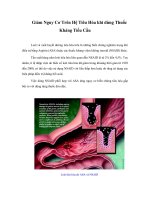Thuốc kháng đông và thuốc kháng tiểu cầu
Bạn đang xem bản rút gọn của tài liệu. Xem và tải ngay bản đầy đủ của tài liệu tại đây (3.36 MB, 90 trang )
THUỐC KHÁNG ĐÔNG
và
KHÁNG TIỂU CẦU
TS. Đinh Hiếu Nhân
Bộ môn Dược lý học
ĐHYD TpHCM
I. Cơ chế đông – cầm máu
TIỂU CẦU
Các yếu tố đông máu
Các thụ thể gắn kết tiểu cầu
12
Thuốc kháng đông: Lịch sử phát triển
Dabigatran
Rivaroxaban
Apixaban
AZD0837
Ximelagatran
clinical trials
Uống
Spoiled
sweet clover
Warfarin
clinical use
Dicoumarol
discovered
1916 1924
1936
1940
Heparin
clinical use
Heparin
discovered
Tiêm
1950s
High / low dose
Warfarin / INR
Warfarin
clinical trials
Warfarin / Vitamin K
mechanism
1970s
1976
LMWH
discovered
Continous heparin
infusion/
aPTT
1980s
1990s
2001
Pentasaccharide
clinical trials
LMWH
clinical trials
2006
Các thuốc kháng đông
Thuốc kháng đông
Đường tiêm
Đường uống
Vị trí tác động
của các thuốc kháng đông
Các thuốc kháng tiểu cẩu
Ticagrelor
Ticagrelor
Thuốc kháng TC
Tiểu cầu và cơ chế tác dụng của các
thuốc kháng tiểu cầu
Ticagrelor
Heparin
15
Heparin is a polymer composed of
heterogenous polysaccharide units
Unfractionated heparin
16
Heparin: cấu trúc hoá học
19
Heparin
Cơ chế tác động
20
Heparins – mechanism of action
All heparins inhibit the coagulation process by enhancing the activity of
the endogenous inhibitor, antithrombin by 1000 x.
Heparins – mechanism of action
The binding of antithrombin to the pentasaccharide sequence in
heparin…
21
Heparins – mechanism of action
The binding of antithrombin to the pentasaccharide sequence in
heparin… …induces a conformational change in antithrombin,…
22
Heparins – mechanism of action
The binding of antithrombin to the pentasaccharide sequence in heparin ,
induces a conformational change in antithrombin, t hereby increasing the
affinity for thrombin by 1000x.
23
Heparins – mechanism of action
The binding of antithrombin to the pentasaccharide sequence in heparin ,
induces a conformational change in antithrombin, thereby increasing the
affinity for thrombin. Unfractionated heparin binds to both antithrombin
and thrombin to form a ternary complex…
24
Heparins – Cơ chế tác động
The binding of antithrombin to the pentasaccharide sequence in heparin ,
induces a conformational change in antithrombin, thereby increasing the
affinity for thrombin. Unfractionated heparin binds to both antithrombin
and thrombin to form a ternary complex… …and then dissociates, leaving
the enzyme irreversibly bound to its inhibitor.
25
Heparins – Cơ chế tác động
The binding of antithrombin to the pentasaccharide sequence in heparin , induces a conformational change in
antithrombin, thereby increasing the affinity for thrombin. Unfractionated heparin binds to both antithrombin and
thrombin to form a ternary complex… …and then dissociates, leaving the enzyme irreversibly bound to its
inhibitor.
Once dissociated, heparin is free …
26
Heparins – Cơ chế tác động
The binding of antithrombin to the pentasaccharide sequence in heparin , induces a conformational change in
antithrombin, thereby increasing the affinity for thrombin. Unfractionated heparin binds to both antithrombin and
thrombin to form a ternary complex… …and then dissociates, leaving the enzyme irreversibly bound to its
inhibitor.
Once dissociated, heparin is free … …to bind to another antithrombin
molecule…
27









